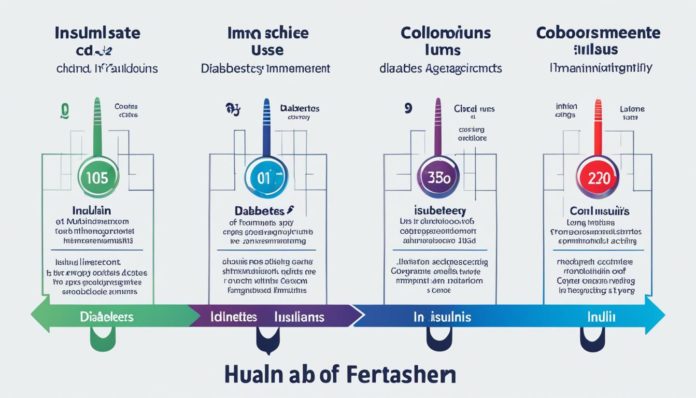Did you know there are more than 7 insulin types for diabetes management? This wide range shows how important personal insulin therapy is. It’s key to controlling blood sugar and improving treatment plans.
Insulin therapy changes lives and is vital for many. With new guidelines, patients have various options. These options meet unique needs and preferences.
Key Takeaways
- There are over 7 different types of insulin available for diabetes management.
- Understanding these types is crucial for effective blood sugar control.
- Personalized insulin therapy can significantly improve treatment outcomes.
- Modern guidelines and recommendations help patients select the best insulin type for their needs.
- Optimizing insulin therapy is essential in enhancing overall diabetes management.
Understanding Insulin and Its Role in Diabetes
Insulin is a key hormone made by the pancreas. It helps our bodies use and store energy from food. For people with diabetes, insulin is even more important. Let’s look at what insulin does and why it’s critical for controlling blood sugar.
What is Insulin?
Insulin lets our bodies use glucose from food for energy. It opens the door for blood sugar to enter cells. This keeps our blood sugar levels just right. When insulin does its job, our bodies have the energy they need.
For those with diabetes, insulin’s role is key. In Type 1 diabetes, the body can’t make insulin. In Type 2 diabetes, the body struggles to use insulin properly. 
How Insulin Controls Blood Sugar
After eating, our blood sugar rises, and our pancreas releases insulin. Insulin helps cells take in glucose for energy. It stores extra glucose in our liver and muscles. This balance helps keep our blood sugar levels stable.
Insulin helps our bodies store glucose, which stops our bodies from breaking down fat and muscle for energy. This is why controlling blood sugar with insulin is vital. It helps avoid serious health problems caused by diabetes.
Why Insulin Therapy is Essential for Diabetes Management
Some people need insulin therapy when their body can’t make enough insulin. This treatment helps keep their blood sugar levels under control. It stops sudden and serious health issues from happening.
Insulin therapy aims to copy how the body normally releases insulin. This keeps blood sugar stable, avoiding too high or too low levels. For many, it’s essential, helping them lead a healthy life despite diabetes.
Knowing how insulin works and its role in therapy is key to managing diabetes. It shows us why we need this hormone and how it helps prevent more problems. This way, people with diabetes can have better health.
Rapid Acting Insulin: Quick and Effective Blood Sugar Control
Rapid Acting Insulin is key for quick Blood Sugar Management, especially around meals. It’s designed to work fast. This makes it essential for effective Diabetes Treatment.

Examples and Brands
Many leading Insulin Brands provide Rapid Acting Insulin. These options are both dependable and effective:
- Humalog (Insulin Lispro)
- Novolog (Insulin Aspart)
- Apidra (Insulin Glulisine)
Doctors often recommend these brands. They reliably manage blood sugar after eating.
Onset, Peak Time, and Duration
Rapid Acting Insulin works quickly, peaks clearly, and lasts a short time:
| Brand | Onset | Peak Time | Duration |
|---|---|---|---|
| Humalog | 15 minutes | 1 hour | 2-4 hours |
| Novolog | 10-20 minutes | 1-3 hours | 3-5 hours |
| Apidra | 10-20 minutes | 30-90 minutes | 1-2.5 hours |
Best Uses for Rapid Acting Insulin
Rapid Acting Insulin is used mainly for:
- Managing sugar spikes after meals.
- Quickly fixing high blood sugar levels.
- Adjusting Blood Sugar Management to fit meals and activities.
It’s vital for personalized Diabetes Treatment plans. It helps control blood glucose better and lowers complication risks.
Long Acting Insulin: Sustained Release for Steady Control
Long-acting insulin is key for steady blood sugar control in diabetes management. It aims to keep a stable insulin level, ensuring effects last for a long time. Let’s explore some examples, their start times, and the best ways to use long-acting insulin in your diabetes care plan.
Examples and Brands
Many patients and doctors prefer certain long-acting insulin products. Some top choices include:
- Lantus (insulin glargine)
- Levemir (insulin detemir)
- Toujeo (insulin glargine)
- Basaglar (insulin glargine)
Onset, Peak Time, and Duration
Knowing how long-acting insulin works is crucial for proper use:
| Brand | Onset | Peak Time | Duration |
|---|---|---|---|
| Lantus | 1-2 hours | None | 24 hours |
| Levemir | 1-3 hours | 6-8 hours | Up to 24 hours |
| Toujeo | 6 hours | None | Up to 36 hours |
| Basaglar | 1-2 hours | None | 24 hours |
How to Incorporate Long Acting Insulin in Your Routine
To add long-acting insulin into your routine, plan and be consistent. Follow your doctor’s advice on when and how much to inject. Most people take their shot once a day, in the evening. However, some might need it twice a day.
Meeting with your healthcare team regularly helps adjust your plan as needed. Long-acting insulin is fundamental in diabetes care. It provides a continuous insulin release. This keeps blood sugar stable. Knowing different types and how they work lets patients use them effectively for better health.
Intermediate Acting Insulin: Balancing Daily Blood Sugar Levels
Choosing the right insulin is key for good diabetes control. Intermediate Acting Insulin is a mix of fast and slow insulins. It helps keep your blood sugar steady all day. This makes it a key part of daily insulin use for many.
Examples and Brands
Here are some well-known Intermediate Acting Insulins:
- Humulin N – A top choice for controlling blood sugar.
- Novolin N – Reliable with consistent results.
- ReliOn/Novolin N – An affordable option at Walmart pharmacies.
Onset, Peak Time, and Duration
Knowing when Intermediate Acting Insulin starts working, peaks, and stops is vital:
| Insulin Type | Onset | Peak Time | Duration |
|---|---|---|---|
| Humulin N | 1.5 – 4 hours | 4 – 12 hours | Up to 24 hours |
| Novolin N | 1.5 – 4 hours | 4 – 12 hours | Up to 24 hours |
| ReliOn/Novolin N | 1.5 – 4 hours | 4 – 12 hours | Up to 24 hours |
Best Practices for Using Intermediate Acting Insulin
To keep your blood sugar in check, use Intermediate Acting Insulin wisely by:
- Taking it at the same times every day.
- Checking your blood sugar often to see how it’s working.
Also, work with your doctor to adjust your dose as needed. Add a balanced diet and regular exercise for the best results. And know how to deal with low blood sugar fast.
Intermediate Acting Insulin is crucial for balancing blood sugar all day. It’s an important part of managing diabetes well.
Ultra-Long Acting Insulin: Extended Coverage for Improved Control
Ultra-Long Acting Insulin has changed Diabetes Management for the better. It provides steady blood sugar control all day. This insulin helps keep glucose levels stable with fewer ups and downs, improving life for those with diabetes.
Examples and Brands
Some well-known ultra-long acting insulins are insulin glargine (Lantus, Basaglar) and insulin degludec (Tresiba). These options meet different needs, making diabetes care better and simpler.
Onset, Peak Time, and Duration
Ultra-long acting insulins start working within one to two hours. They offer a steady insulin level for a long time without a big peak. For instance, Tresiba can last over 42 hours, helping keep blood sugar stable and lowering hypoglycemia risks.
Who Can Benefit Most from Ultra-Long Acting Insulin
People with busy lives or those who don’t want to take insulin often benefit most from ultra-long acting insulins. It’s also good for those with big blood sugar changes overnight or between meals. Stable glucose levels from this insulin make diabetes easier to manage.
Today’s ultra-long acting insulin analogs are the result of in-depth research. For more on how they were developed and work, take a look at this detailed article.
Insulin Analogs: Tailored for More Precise Management
Effective diabetes care involves using insulin analogs. These insulins are like the body’s own insulin but better. They help manage diabetes very precisely.
What Are Insulin Analogs?
Insulin analogs are changed up forms of insulin. They absorb in more predictable ways. They can work faster or longer than regular insulins, meeting the body’s needs well.
Advantages Over Conventional Insulins
Choosing insulin analogs over old-style insulins has many pluses:
- Better predictability: They control blood sugar more evenly.
- Flexibility: You can adjust when and how much you take easily.
- Reduced risk of hypoglycemia: They cut down the chance of low sugar levels at night.
These benefits make insulin analogs a key part of today’s diabetes care.
Examples of Insulin Analogs
There are several key types of insulin analogs out there:
| Brand Name | Type | Action Time |
|---|---|---|
| Humalog | Rapid-acting | 15 to 30 minutes |
| Lantus | Long-acting | Up to 24 hours |
| Levemir | Long-acting | Up to 24 hours |
With these advanced insulin therapy choices, patients can tailor their diabetes management to fit their lives better.
Different Methods of Administering Insulin
Managing diabetes well means using the right way to take insulin. You must keep blood sugar levels stable. There are main ways like injections, insulin pumps, and inhaled insulin. Each one has its benefits depending on what each person needs and likes.
Injections are a long-time standard. With syringes or pens, they’re simple and work well. Insulin pumps give insulin non-stop for better sugar control. Inhaled insulin is great for those who don’t like needles as it goes in through the lungs.
Here is a simple look at these methods:
| Method | Advantages | Considerations |
|---|---|---|
| Injections | Widely available, easy to use | May require multiple daily doses |
| Insulin Pumps | Constant insulin delivery, customizable doses | Requires wearing a device continually |
| Inhaled Insulin | Needle-free, rapid absorption | Not suitable for all patients, limited dosage options |
Talking to health experts is key to picking the best insulin method for you. Looking at all choices helps you find the best fit for your health aims.
Types of Insulin: Finding the Right Fit for Your Needs
Choosing the right insulin is key for good diabetes control. It’s important to tailor your insulin therapy to fit your unique needs. This includes looking at your daily habits and blood sugar levels. Consulting with diabetes experts can help you create the best insulin plan for you.
Factors to Consider for Choosing Insulin Types
Picking the right insulin involves many factors. These factors include your routine, lifestyle, and how your body reacts to insulin. Things like when you eat and how much you exercise also play a big role. Talking with diabetes experts can guide you in making the best choice for your treatment.
Combination Therapies
Using more than one type of insulin can control blood sugar better. Mixing short-acting and long-acting insulins helps keep blood sugar stable all day. For example, combining rapid-acting and long-acting insulin helps with mealtime sugar spikes and overall needs. This approach can lead to better control of blood sugar and lower the chance of low blood sugar levels.
Consulting with Healthcare Providers
Meeting regularly with diabetes healthcare providers is important. They give advice based on the latest research and your specific situation. These check-ups also allow for changes in your insulin plan as needed. Getting personalized care from these experts means better and safer diabetes management.
FAQ
What are the different types of insulin available for diabetes management?
There are several insulin types for diabetes, like rapid, long, and ultra-long acting insulin. Each one works differently and has its timing for controlling blood sugar. They help manage diabetes in various ways.
How does insulin regulate blood sugar levels?
Insulin helps blood sugar enter cells, lowering its levels. It energizes the cells too. The pancreas makes insulin, vital for healthy blood sugar.
Why is insulin therapy crucial for managing diabetes?
For people with diabetes, insulin therapy is a must. It helps keep blood sugar right, avoiding heart, nerve, or kidney issues.
What are some examples and brands of rapid-acting insulin?
Rapid-acting insulins like Humalog, NovoLog, and Apidra work fast. They start in 15 minutes, peak in 1 to 2 hours, and last for 3 to 5 hours.
How do long-acting insulins work to provide steady blood sugar control?
Long-acting insulins, such as Lantus and Levemir, release insulin slowly. They keep blood sugar stable all day and night.
What is the function of intermediate-acting insulin in diabetes management?
Intermediate-acting insulins, like NPH, start in 1 to 2 hours and peak in 4 to 12. They control blood sugar between meals and at night.
Who can benefit most from ultra-long acting insulin?
Ultra-long acting insulins, like Tresiba, work for more than 24 hours. They help those with hard-to-manage blood sugar levels.
What are insulin analogs, and how do they differ from conventional insulins?
Insulin analogs are modern, tailored insulins. Compared to old-school insulins, they work more like the body’s insulin. They help avoid blood sugar highs and lows.
What are the various methods for administering insulin?
Insulin can be given through shots, pens, pumps, or inhalers. Each way has its pros for different people’s lives.
How do you choose the right type of insulin for diabetes treatment?
Choosing insulin involves looking at your life, sugar control goals, and needs. A doctor can help mix insulins for the best control. Always talk to a healthcare provider to get the right plan.
What is combination insulin therapy?
Combination insulin therapy uses different insulins for tighter blood sugar control. It blends rapid and long-acting insulins for balanced care.
Why is consultation with healthcare providers important when managing diabetes with insulin?
Talking to healthcare providers is key for tailored insulin plans. They help adjust treatment and ensure it works safely and effectively.


